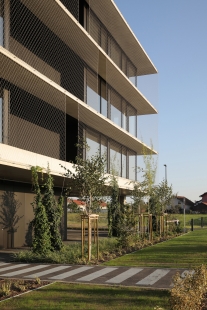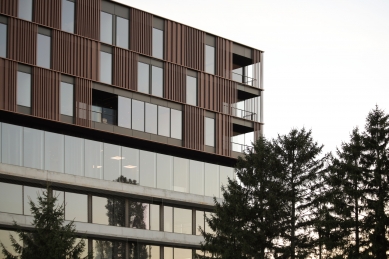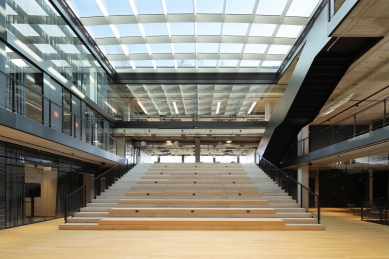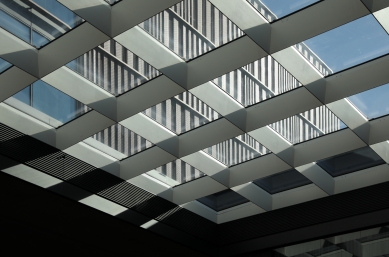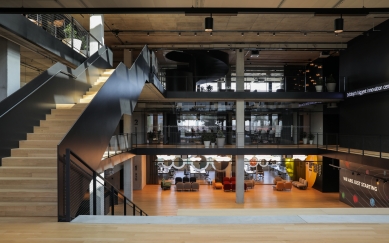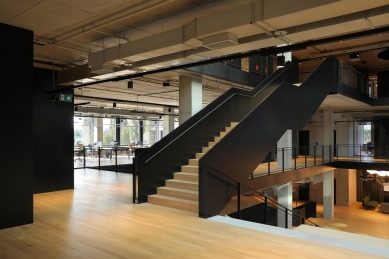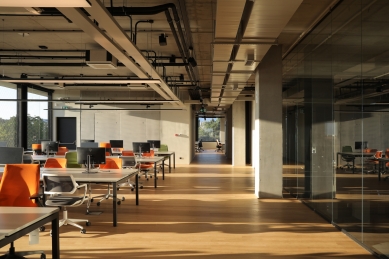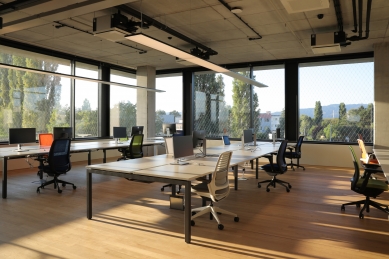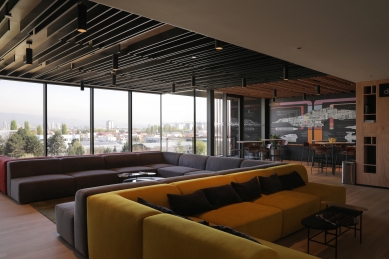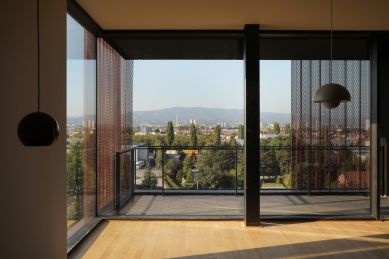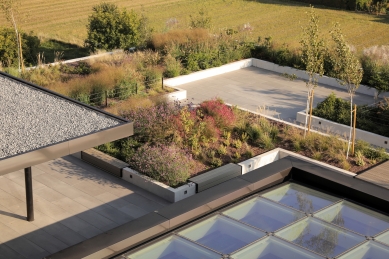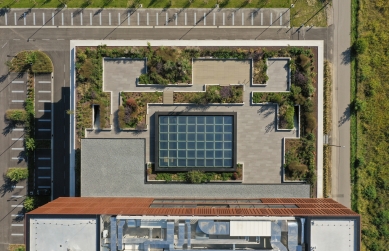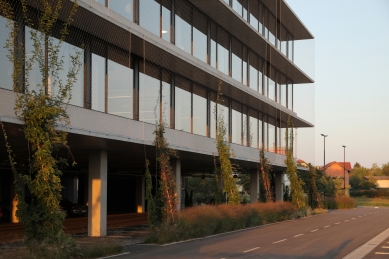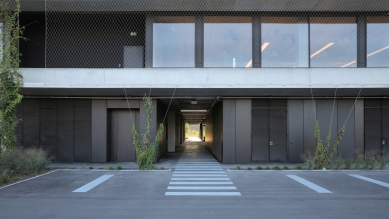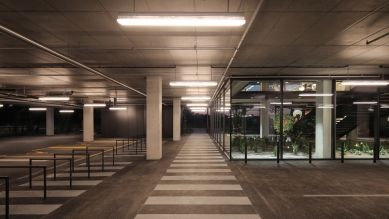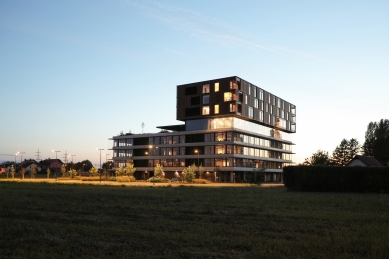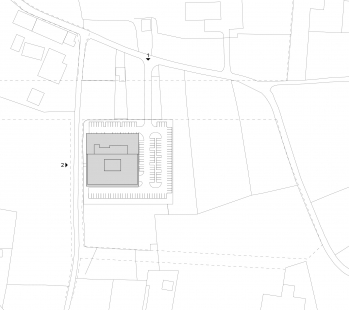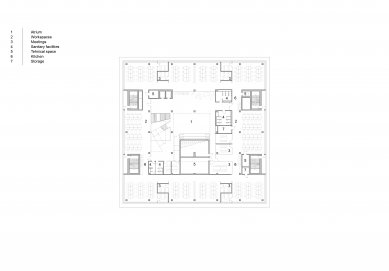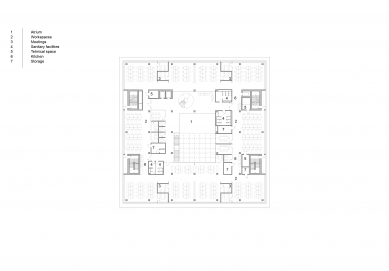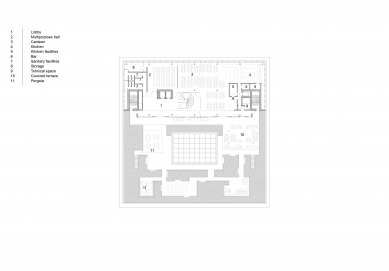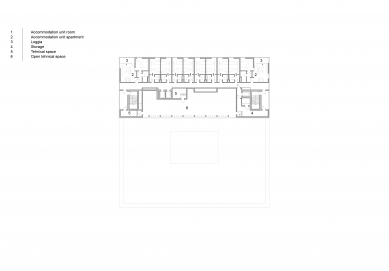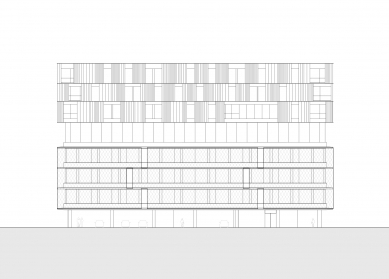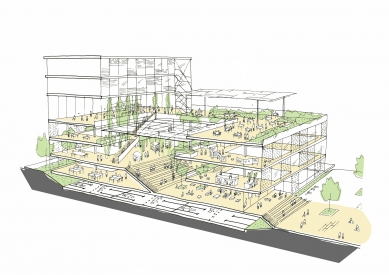
Campus Infobip

Infobip is a unicorn IT company based in Vodnjan, Istria, where it also built its first campus. The company's rapid growth has spawned the need for a new hybrid building in Zagreb. Infobip is located on a plot on the southern edge of Zagreb, in a rurban zone bordering New Zagreb, directly next to the corridor of the newly planned avenue that will, once it is built, run along the southern edge of Zagreb. The zone is an entropic and poorly regulated area with low-rise medium-density multi-dwelling buildings lacking both an articulated public space and nature.
The campus is hybrid in character in several ways. The investor requested that, in addition to the offices, a residential section be created for employees and guests, as well as other accompanying facilities such as a restaurant, spaces for recreation and a conference hall. Also, this prestigious investor's campus with highly qualified employees had to compensate for all the shortcomings of an environment that lacks an urban context and is without surrounding nature. This is why the campus is conceived as a self-sufficient organism that provides its employees with everything they need during the work day, and even beyond. The hybrid character of the project has led to the concept of stacking the spatial and programme elements on top of each other, with the transitional floors - the ground floor and public floor between the base and the vertical block - playing a key role in the spatial scenario.
The building volume is raised from the ground, and the entire ground floor is a spacious, open and covered garage from which the lobby is entered. The ground floor functions as a transition from the outside world to the world of the corporation. The three-floor base of the building contains office spaces organised around a large atrium with zenithal lighting, which serves as an auditorium and a gathering space. The atrium also functions as a spacious promenade, while the sculptural staircase, placed along the edge of the atrium and made of black steel, can be used to reach the upper floors faster. The movement routes through the atrium and the staircase are complementary and merge into a vertical circular connection that brings together the different programme elements. Views of the atrium and auditorium, as well as the facades of the offices that are across from each other, create a dynamic urban atmosphere in contrast with the suburban surroundings.
A closed cylindrical staircase leads from the three-floor base to the next sector of the vertical programmatic composition, the public floor. This is a transitional space between the office zone and the dormitory in the vertical block and it features facilities that correspond to the multiple functions of the campus: a restaurant, which is also a space for conferences and meetings, as well as a luxurious park terrace with micro-urban elements whose streets and small squares-booths meander around cultivated nature.
While the composition of the building as a whole is pragmatic, the utmost effort has been invested in the careful coordination of all constructive elements, with the building's impeccably neat infrastructure showcased explicitly. The concrete load-bearing structure as well as all technical elements (air conditioning, fire protection system and lighting) receive equal representation as any other design element in the building and are all laid bare in their original form. The same goes for the exterior of the building, which features a bare concrete structure, a glass infill and screens placed on the front of the upper volume. Instead of using double-skin facades, which are often not as energy efficient as they claim to be, the large glass panes are doubly protected from the sun by simple construction solutions rather than by means of technology: the mezzanine panel brackets and the mantle of greenery that will enshroud the building with time.
Both the stacking concept and the explicitness of the tectonic and installation structures equally contribute to the design of the building. The materials and details are not treated in a distinct way, nor do different rules apply to the articulation of the "architecture" on the one hand and the "installations" on the other. Quite the opposite, they are markedly designed to be synchronous equal layers. At the Infobip campus, we clearly see and understand the way in which a building can function as a spatial and technological organism that is complete unto itself, demonstrating a "functional and conceptual transparency". Such an approach was possible owing to the use of integrated BIM design software tools, some of which were developed by 3LHD, which set new paradigms for the design of a building as a whole.
The Infobip project sets new standards for corporate architecture in Croatia. The campus offers a stimulating work environment, and the model of "functional and conceptual transparency" represents a contribution to the local culture of construction and design. This project introduces into the suburban entropic landscape a conceptually and technically precise architecture that advocates for rational values and is aligned with the ambitions of a globally relevant investor. The Infobip campus demonstrates that it is precisely peri-urban areas on the edge of the city, unencumbered by issues of identity, historical heritage and other parameters, that will be best suited as a proving ground for architectural exploration and the testing of typologies that are self-sufficient, but not autistic.
The campus is hybrid in character in several ways. The investor requested that, in addition to the offices, a residential section be created for employees and guests, as well as other accompanying facilities such as a restaurant, spaces for recreation and a conference hall. Also, this prestigious investor's campus with highly qualified employees had to compensate for all the shortcomings of an environment that lacks an urban context and is without surrounding nature. This is why the campus is conceived as a self-sufficient organism that provides its employees with everything they need during the work day, and even beyond. The hybrid character of the project has led to the concept of stacking the spatial and programme elements on top of each other, with the transitional floors - the ground floor and public floor between the base and the vertical block - playing a key role in the spatial scenario.
The building volume is raised from the ground, and the entire ground floor is a spacious, open and covered garage from which the lobby is entered. The ground floor functions as a transition from the outside world to the world of the corporation. The three-floor base of the building contains office spaces organised around a large atrium with zenithal lighting, which serves as an auditorium and a gathering space. The atrium also functions as a spacious promenade, while the sculptural staircase, placed along the edge of the atrium and made of black steel, can be used to reach the upper floors faster. The movement routes through the atrium and the staircase are complementary and merge into a vertical circular connection that brings together the different programme elements. Views of the atrium and auditorium, as well as the facades of the offices that are across from each other, create a dynamic urban atmosphere in contrast with the suburban surroundings.
A closed cylindrical staircase leads from the three-floor base to the next sector of the vertical programmatic composition, the public floor. This is a transitional space between the office zone and the dormitory in the vertical block and it features facilities that correspond to the multiple functions of the campus: a restaurant, which is also a space for conferences and meetings, as well as a luxurious park terrace with micro-urban elements whose streets and small squares-booths meander around cultivated nature.
While the composition of the building as a whole is pragmatic, the utmost effort has been invested in the careful coordination of all constructive elements, with the building's impeccably neat infrastructure showcased explicitly. The concrete load-bearing structure as well as all technical elements (air conditioning, fire protection system and lighting) receive equal representation as any other design element in the building and are all laid bare in their original form. The same goes for the exterior of the building, which features a bare concrete structure, a glass infill and screens placed on the front of the upper volume. Instead of using double-skin facades, which are often not as energy efficient as they claim to be, the large glass panes are doubly protected from the sun by simple construction solutions rather than by means of technology: the mezzanine panel brackets and the mantle of greenery that will enshroud the building with time.
Both the stacking concept and the explicitness of the tectonic and installation structures equally contribute to the design of the building. The materials and details are not treated in a distinct way, nor do different rules apply to the articulation of the "architecture" on the one hand and the "installations" on the other. Quite the opposite, they are markedly designed to be synchronous equal layers. At the Infobip campus, we clearly see and understand the way in which a building can function as a spatial and technological organism that is complete unto itself, demonstrating a "functional and conceptual transparency". Such an approach was possible owing to the use of integrated BIM design software tools, some of which were developed by 3LHD, which set new paradigms for the design of a building as a whole.
The Infobip project sets new standards for corporate architecture in Croatia. The campus offers a stimulating work environment, and the model of "functional and conceptual transparency" represents a contribution to the local culture of construction and design. This project introduces into the suburban entropic landscape a conceptually and technically precise architecture that advocates for rational values and is aligned with the ambitions of a globally relevant investor. The Infobip campus demonstrates that it is precisely peri-urban areas on the edge of the city, unencumbered by issues of identity, historical heritage and other parameters, that will be best suited as a proving ground for architectural exploration and the testing of typologies that are self-sufficient, but not autistic.
0 comments
add comment




